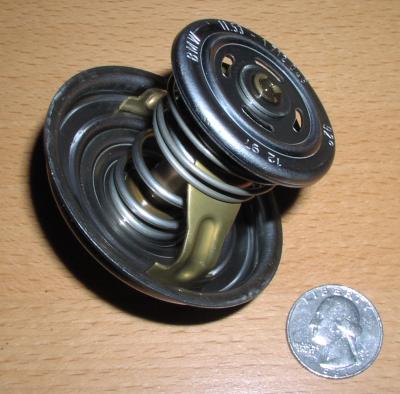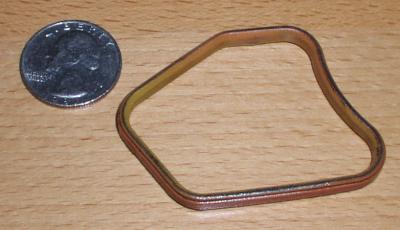Wednesday, December 17, 2003
Thermostat Replacement
The first two years I drove the car on a daily basis, including during the depths of winter. During that time I was always impressed at how quickly the car would warm up and retain heat for a considerable time after shutdown. For ownership years 3 and 4 the car never left the garage on cold, crummy days.
When I brought the car back into routine service in year 5 and the weather turned cold, I noticed that the termperature gauge would no longer rise to the 12 o'clock position (vertical). The effect became more pronounced as the temperatures dropped below 35 degrees (pretty common here in NJ from late November to March). I shrugged it off as "normal" and drove all last winter with the gauge about 2-3 needle-widths on average below the vertical.
 We had been enjoying fairly mild weather for some time this season, until a cold
snap hit, with temperatures in the 20's and 30's. It was during this time I
that noticed the temperature gauge riding lower than last season. Particularly
while cruising at 80 MPH on the highway, the needle hovered around the tick
mark on the face of the gauge about 1/3 the way up from the cold position. When
the temperature rose to about 50 degrees a few days later (gotta love this crazy
New England weather) the average reading rose again, but remained within a few
needle-widths of the vertical.
We had been enjoying fairly mild weather for some time this season, until a cold
snap hit, with temperatures in the 20's and 30's. It was during this time I
that noticed the temperature gauge riding lower than last season. Particularly
while cruising at 80 MPH on the highway, the needle hovered around the tick
mark on the face of the gauge about 1/3 the way up from the cold position. When
the temperature rose to about 50 degrees a few days later (gotta love this crazy
New England weather) the average reading rose again, but remained within a few
needle-widths of the vertical.
If you know how automotive cooling systems work, this is a pretty easy diagnosis. I figured the thermostat just wasn't sealing properly, and was allowing coolant to flow out of the block and through the radiator, even when it was supposed to be fully closed.
I dropped by the dealer to speak with my mechanic, and he said that thermostats are one of the "hot items" on this model car. Turns out the thermostat on this car is of the simple mechanical variety (unlike the E46 and later rev cars which are electronically controlled), and this lower-than-normal temperature is a symptom of a weak spring or a degradation of the wax pellet that prevents opening of the thermostat until the coolant comes up to the rated temperature.
He said that replacement of the thermostat is a pretty simple procedure, and since the engine temperature wasn't dropping into the "cold" region, it wasn't doing any damage to the engine, but he agreed with me when I suggested that it was probably "cheap insurance" to replace it before it failed completely and left me without heat.
I got an appointment a week later and happened to watch the entire process, which took about 45 minutes to complete. It involved removing the black panel covering the top of the radiator (which also serves as a means to direct cooling airflow to the alternator). This exposed the radiator, which, incidentally, is far easier to replace than I thought. Remove few hoses and a couple mounting clips, and it slides right out. In fact, I imagine the thermostat would be much easier to get to with the radiator removed, so if I had to replace the radiator, I'd definitely do the thermostat at the same time....but I digress.
After inspecting the face of the radiator, he showed me that some leaves and other light debris had found their way into a space at the front base of the radiator. The debris wasn't blocking the radiator it to any great extent, but my mechanic naturally blew those out with a 2' long wand attached to a compressed air hose before continuing.
He then removed he engine-driven fan, a support bracket on the oil-driven VANOS actuator on the top-front of the engine (which apparently shares a bolt with the black high-density plastic thermostat housing), the 2" coolant hose attached to the housing, and then the housing itself.
 After the housing was removed he inspected it for leaks and cracks. He pointed out
a couple white stains around its perimeter indicative of leaks, and said that
the coolant is specially formulated to leave these "stains" behind
to help find leaks long after the coolant has evaporated or burnt off.
After the housing was removed he inspected it for leaks and cracks. He pointed out
a couple white stains around its perimeter indicative of leaks, and said that
the coolant is specially formulated to leave these "stains" behind
to help find leaks long after the coolant has evaporated or burnt off.
Then, he pointed out some minor damage to the housing seal (pictured) and said it's pretty common for the antifreeze to crystalize at the interface of the housing and the seal, and this can ultimately cause the seal to be "pushed out" of the recess built into the housing for it, which ultimately causes leaks. I don't know if this was responsible for the (very) modest coolant loss I'd experienced over the last few years, but it seemed as good a probable cause as any.
After verifying that the replacement thermostat was the same temperature as the original (92 degrees C), he swapped the parts and put everything back together. If you look closely at the thermostat, you'll see the manufacturing date - this one was built six years ago to the month.
When it came time to refill the system with fresh coolant, my mechanic loosened the plastic vent screw slightly forward and to the right of the overflow bottle filler. This is required to allow air to escape the system and the coolant to fully fill the radiator. If you do not open this vent, the system will not fill completely (even though it will appear full). Note that because of this vent you do NOT need to run the engine while filling the coolant, but my mechanic nevertheless started the engine shortly before pulling the car out of the shop to ensure all air pockets had been purged and the coolant level was proper.
The car was supposed to be returned to me within an hour, but as it turned out my mechanic (who is also the lead tech in the shop) had to meet with a BMW engineer that dropped by just as I had arrived. For that reason, about two hours had passed since I'd arrived, so my mechanic offered to throw in the biennial coolant flush ($120) in for free. There was no real additional work, as replacing the thermostat drains roughly 1/3 of the coolant anyway, so all I really got was a few gallons of coolant for free...but I'll take what I can get! Christmas came early this year!
I then did my rounds, wished everyone a good holiday (especially the cute 20-something receptionist), and left with the coolant temperature needle perfectly vertical - exactly where it should be.
Cost: Parts, $35, Labor $135, Total $180. Mileage: 88215.



